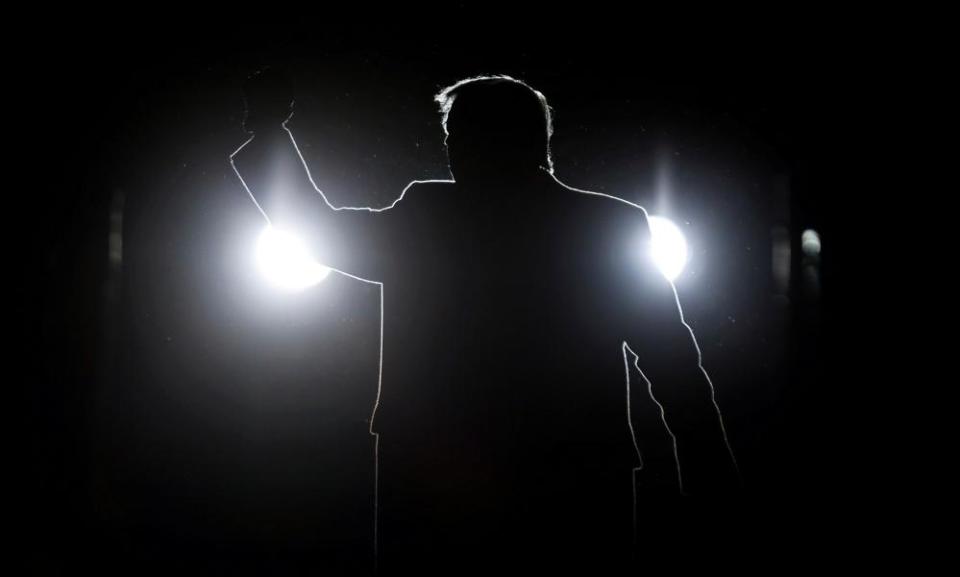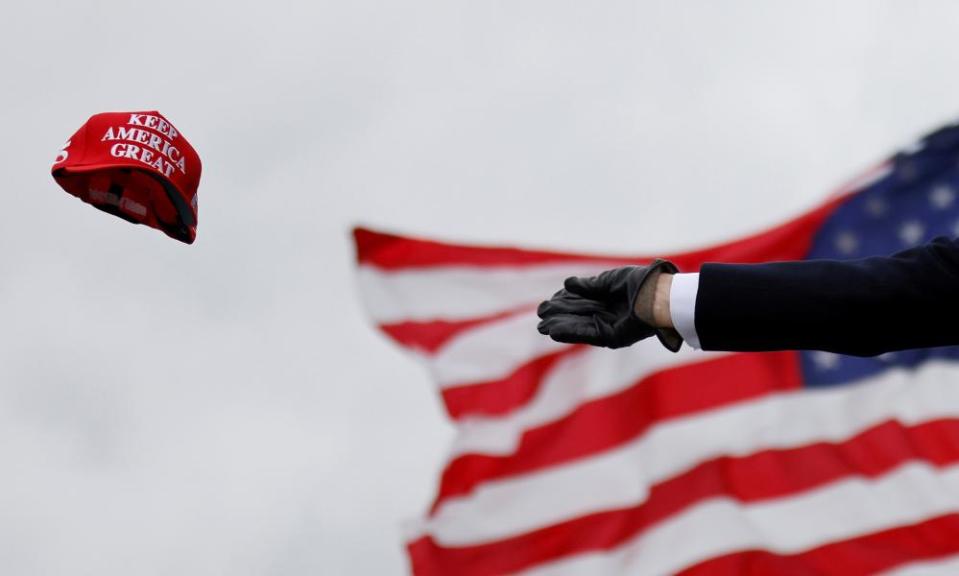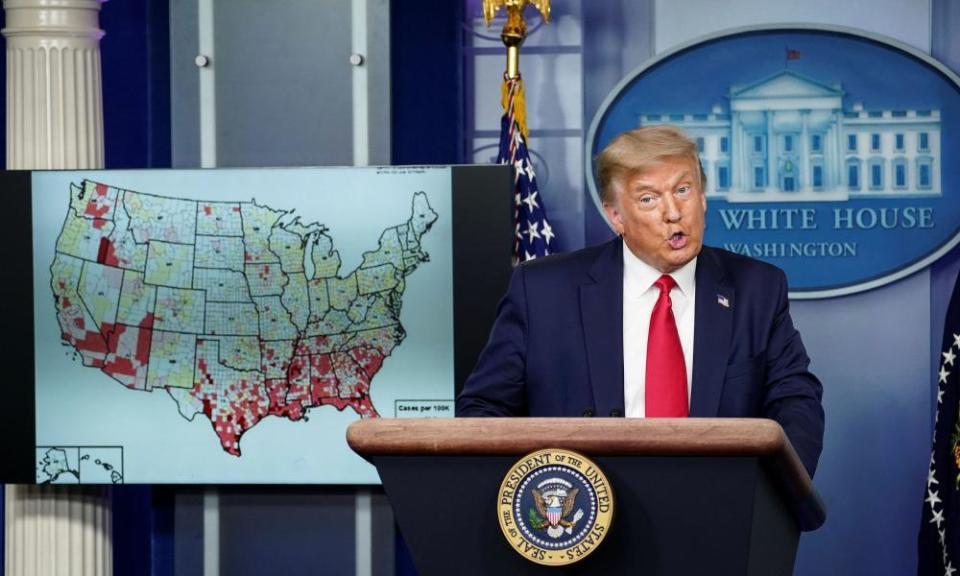Trump's presidency: a lesson in the true meaning of 'American carnage'

In a cold, sombre, damp Washington four years ago this Wednesday, Donald Trump took the oath of office as the 45th president of the United States and delivered an inaugural address now remembered for two words: American carnage.
He delivered, but not as he promised. Trump pledged to end the carnage of inner-city poverty, rusting factories, broken schools and the scourge of criminal gangs and drugs. Instead his presidency visited upon the nation the carnage of about 400,000 coronavirus deaths, the worst year for jobs since the second world war and the biggest stress test for American democracy since the civil war.
Related: Democracy in Trumpland: I won because I say so | Ed Pilkington
“It’s not just physical carnage,” said Moe Vela, a former White House official. “There’s also mental carnage and there’s spiritual carnage and there’s emotional carnage. He has left a very wide swath of American carnage and that is the last way I would want to be remembered by history, but that is how he will be remembered.”
Trump campaigned for president as a change agent but millions came to regard him as an agent of chaos. His line-crossing, envelope-pushing, wrecking-ball reign at the White House crashed in a fireball of lies about his election defeat and deadly insurrection at the US Capitol. Future generations of schoolchildren will read about him in textbooks as a twice-impeached one-term president.
It all began in earnest in June 2015 when the property tycoon trundled down an escalator at Trump Tower in New York and announced a presidential run based on “America first” nationalism and building a border wall. Exploiting white grievance, economic dislocation and celebrity culture, he clinched the Republican nomination and promised: “I alone can fix it.” He lost the national popular vote to Hillary Clinton but lucked his way to victory in the electoral college.
The first person elected to the White House with no previous political or military experience, he represented a shock to the system and rebuke to the establishment.
Ian McEwan, the British novelist, observed in the Guardian: “Charles Darwin could not believe that a kindly God would create a parasitic wasp that injects its eggs into the body of a caterpillar so that the larva may consume the host alive … We may share his bewilderment as we contemplate the American body politic and what vile thing now squats within it, waiting to be hatched and begin its meal.”

Hopes that Trump would “pivot” and become “presidential” were dashed by that speech on 20 January 2017. A day later, the press secretary, Sean Spicer, tried to mislead the nation about the size of the inaugural crowd, and soon after the White House counsellor Kellyanne Conway was defending Spicer’s “alternative facts”. It was the outbreak of a disinformation pandemic.
Trump, by all accounts, tried to govern by gut instinct, refusing to read national security briefs but hanging on the words of hosts on the Fox News network. His Twitter feed gave an astonishing window on his thinking and frayed the nation’s nerves. He showed a narcissist’s craving for attention from the media and affirmation from West Wing staff, who came and went at a record rate.
He assailed government bureaucracy, sought to undo Barack Obama’s legacy and displayed the brashness and shamelessness that served his business career: hurl insults, never apologize, hit back harder and throw out constant distractions. He aped demagogues of the past by handing his family top jobs and deriding the media as “fake news” and “the enemy of the people”.
In his first year alone, Trump signed an executive order to prevent people from seven Muslim-majority countries from entering the US, fired the FBI director, James Comey, and other officials whose loyalty was less than absolute, announced America’s withdrawal from the Paris climate agreement and responded to deadly white nationalist violence in Charlottesville, Virginia, by insisting that there were “very fine people on both sides”.
Donald Trump is the first president in my lifetime who does not try to unite the American people
Jim Mattis
As his term went on, Trump oversaw a “zero-tolerance” policy at the border that separated immigrant parents from children and stripped away environmental regulations. He encouraged the QAnon conspiracy movement, described as a domestic terror threat by the FBI. In language often laced with violent imagery, it was all about “owning the libs” and mesmerising the “Make America great again” base at cultish rallies.
Jim Mattis, a retired four-star Marine Corps general who served as his first defence secretary, said last year: “Donald Trump is the first president in my lifetime who does not try to unite the American people – does not even pretend to try. Instead he tries to divide us.”
Yet for three years, his beginner’s luck held and re-election seemed possible. An investigation into links between Russian meddling in the 2016 election and Trump’s campaign led to several criminal convictions but ultimately ended in anticlimax. He was impeached by the House of Representatives for pressuring Ukraine for political favours but was comfortably acquitted by the Senate.
Trump gratified Republicans by naming three supreme court justices and more than 220 federal judges, giving the judiciary an enduring conservative bent, and enacting the biggest tax cuts and reforms for a generation. He invested in the military and brought troops home, negotiated a new trade deal with Canada and Mexico and helped broker agreements between close ally Israel and three Arab states.

Newt Gingrich, a former Republican House speaker, said: “It was a remarkably effective populist disruption of the old order. It changed regulations, it rebuilt the American military, it recentred American foreign policy on American interests, it renegotiated trade policy around American jobs, it began to fundamentally shift the judiciary system back to a constitutional basis. And at the same time it was generating economic growth so you had the lowest Black and Latino unemployment in American history.”
Using a term that had led to widespread criticism of Trump for fuelling racism, Gingrich added: “Except for the enormous intrusion of the Chinese virus, it was an astonishingly successful period.”
But the coronavirus did change everything. From the start, Trump deliberately played down the threat and failed to build a national testing strategy. He sidelined public health officials by refusing to embrace mask-wearing and suggesting unproven treatments, including the injection of disinfectant, and was eventually hospitalised with the virus himself. Vaccines came at historic speed but their distribution lagged and was described by President-elect Joe Biden as a “dismal failure”.
Trump was a symptom of many problems, not the cause
Arisha Hatch
The summer brought another crisis. Faced with mass protests against racial injustice, Trump responded with brute force, law-and-order rhetoric and a renewed culture war over statues and Confederate symbols. On 1 June, security forces chased away peaceful protesters with teargas outside the White House before the president staged a photo op, awkwardly clutching a Bible at a historic church.
But for every action, there is an equal and opposite reaction. The Trump era was also the era of #MeToo and Black Lives Matter. His inauguration was immediately followed by women’s marches including a record 4 million people in Washington. The “resistance” was maintained by activists, journalists, politicians, satirists, watchdogs, whistleblowers and voters, who delivered their verdict by handing Democrats the House, then the White House, then the Senate.
By tapping America’s id, the president inadvertently did it a favor by bringing all its internal tensions and tormented histories to the surface, making them far harder to deny. Arisha Hatch, vice-president of the activist group Color of Change, said: “Trump’s four years in office led to a huge degree of suffering but it will also be remembered as a time of racial reckoning, a time when racial justice finally became a majoritarian issue.
“Trump will be remembered for exposing the flaws in our democracy that have, for decades, kept us from achieving racial equity. Trump was a symptom of many problems, not the cause.”

Trump once boasted that he could shoot somebody on New York’s Fifth Avenue and not lose any voters, an insight vindicated time and again, including when he grew his support from 63m votes in 2016 to 74m in 2020, more than any incumbent president in history. But his opponent, Biden, gained a record 81m votes and won 306-232 in the electoral college. Trump refused to concede and launched a scorched earth campaign of lawsuits, fantasies and propaganda to overturn the result.
But the officials, courts, civil society and media held firm. As Trump turned on his closest allies, including even Vice-President Mike Pence, weeks of election denialism and years of inflammatory rhetoric reached a fiery climax when a mob sacked the US Capitol, flaunting the Confederate flag and other far-right iconography. Five people died and members of Congress cowered in fear.
That was the first time I thought, ‘It really could happen here’
Gwenda Blair
Gwenda Blair, a Trump biographer, said: “That was perhaps the first time I was truly shocked and truly, personally, physically frightened. I’ve been frightened on every other level before but that was the first time I thought, ‘It really could happen here’. It was the first time that all of the norms and all the notions of it being somewhere else were completely blown away.”
Blair was interviewed by the Guardian in a New York diner in July 2015 as Trump began his political ascent. Looking back on all that has happened since then, she reflected: “It’s a combination of exactly what I expected and worse than I could have imagined. It’s utterly consistent with his entire career but, even as someone who has been watching him for more than 30 years, it’s hard to wrap my mind around.”
From carnival barker to world’s most powerful man, Trump, 74, leaves a legacy of division, destruction and death. He accelerated Americans’ distrust in institutions and in each other, waging war on truth itself. He still has millions of acolytes whose divorce from the reality of a Biden’s presidency threatens further instability and violence from domestic terrorists. Overseas, Trump made America an object of ridicule, scorn or pity as he gravitated towards foreign autocrats and alienated longtime allies.

Leon Panetta, a former defence secretary and CIA director, said: “Future historians will say that it was perhaps the worst presidency the United States has had because of the person Trump is and because he had little respect for the values associated with the presidency, did not believe that there were any rules that constrained him and generally undermined the strength of the United States at a very critical time, both at home and abroad.”
But on Wednesday the lights will go out on the reality TV presidency as Trump exits the White House in defeat and disgrace, facing another impeachment trial in the Senate. A Pew Research Center poll found that his approval rating has collapsed to 29%, the lowest of his presidency. He has even been banned from social media, depriving him of the Twitter megaphone that gave diplomats and journalists sleepless nights.
In addition to being the worst president, he’s a terrible person. What a combination
Larry Sabato
Biden will be inaugurated in a city resembling a fortress and begin clearing up four years of carnage. Former president Gerald Ford’s proclamation after the departure of Richard Nixon – “our long national nightmare is over” – will be widely quoted. Many will hope that Trump was a mere heartbeat in historical terms, a blip as the baton passed from Obama to Biden, and a warning to the future: let’s not do that again.
Larry Sabato, director of the Center for Politics at the University of Virginia, said: “If history is honest, it will remember Donald Trump as by far the worst president ever. No one else even comes close. Not Warren Harding, not James Buchanan, not Richard Nixon. Nobody comes close.
“And beyond that he is, in my view, the most horrible human being who has ever sat in the Oval Office. In addition to being the worst president, he’s a terrible person. What a combination. I hope we’ve learned this lesson. This ought to remind all Americans what happens when you make a mistake with your vote.”

 Yahoo Movies
Yahoo Movies 